1. WHAT UNITED THE GREEKS OF HELLAS?
Ancient greeks were a mix of peoples who had settled on the south of the Balkan Peninsula and on the coast of Asia Minor since the 2nd millenium BC.
 |
| Mytikas peak, the highest point of the Mount Olympus. Mount Olympus (2.900 meters of height) is the highest mountain in Greece, and ancient greeks thought the gods lived in its peak, the Mytikas. |
The Hellenic Peninsula has a lot a small valleys between mountains, because of this the Greek world was organised into independent city-states, called poleis with its own laws and armies that fought each other. Nevertheless, all greeks considered themselves a part of Hellas, "the country of the Hellenes" (Greeks), because they shared several features:
A common origin:
They shared the same origin: the Minoian and Mycenaean civilisations which appeared in the Aegean Sea.- Minoan civilisation, appeared in Crete around 2.600 B. C. The main city was Knossos.
- Mycenian civilisation, appeared in the Peloponese between 1.600 and 1.200 B. C. Its main feature were the cities with fortified palaces ruled by a king, such as Mycenae (in spanish, Micenas).
 |
| Ruins of the palace of Knossos. |
 |
| Fresco, Cnosos. |
 |
| Lion Gate, Micenas. |
 |
| The fresco goddess or priestess with spikes, 1250-1180 BC. File:Myken_M_091011.jpg Author: https://commons.wikimedia.org/wiki/User:Zde License: CC BY-SA 3. 0 |
 |
| Mask of Agamenon, National Museum of Athens. A funerary mask found in Mycenas. |
Assassins Creed Discovery Tour Cnossos (Minoan civilization)
Assassins Creed Discovery Tour Mycenas (Micenic civilization)
The same language and culture
- All greeks spoke the same language and used a syllabic alphabet with vowels.
- The same culture and literature which provided them with a common history, such as the poems of Homer (8th century BC):
- The Iliad tells of the war between the Greeks and Trojans following the abduction of Helen, wife of the king of Sparta, by Paris, a trojan hero.
- The Odyssey tells of the adventures of Odysseus, the king of Ithaca, on his journey home from the Trojan War.
The greek alphabet: letter's names and pronunciation.
An example of spoken Ancient Greek.
Modern Greek (the greek language spoken today) uses the same alphabet as Ancient Greek, but the grammar, the pronunciation and the vocabulary is different and modern greek speakers can't understand Ancient Greek. "Let it go" sung in modern Greek.
Do you want to build a snowman in modern greece. Our alphabet is based in the greek alphabet and is possible to translate most of the sound of Modern Greek using the latin alphabet.
Judgement of Paris.
The Iliad.
The Odissey.
A short sketch about Helen of Troy.
Did ancient Troy really exist? TED-ED
The same gods and rituals.
The main characteristics of the greek religions were:- It was a polytheistic religion, they had many gods.
- The gods were anthropomorphic (they were represented in human form and guided people's lives.
- The gods had powers and they were inmortal, but they all had the same passions, vices and virtues than humans.
- They also believed in demigods (heroes), born from a union between a mortal and a god.
- Greek myths were tales about the faboluous adventures of its gods and heroes.
- They celebrated reiligious and sporting festivals to honour their gods. In some of them, the Panhellenich festivals, such of Zeus in Olympia and Apollo in Delphi, took part people from all Greece.
- The main gods were:
- Zeus/Jupiter (roman name): The ruler of Mount Olympus.
- Hera/Juno: Goddess of the home.
- Hades/Pluto: God of Hell.
- Poseidon/Neptune: God of the oceans.
- Ares/Mars (in spanish Ares/Marte): God of war.
- Artemis/Diana (in spanish Artemisa/Diana): Goddess of hunting
- Apollo (in spanish Apolo): God of the Sun, poetry and music.
- Athena/Minerva (in spanish: Atenea/Minerva): Goddess of wisdom
- Hermes/Mercury: God of travel and routes. The mesenger of the gods
- Dionysus/Bacchus: God of wine
- Aphrodite/Venus: Goddes of love and beauty.
- Demeter/Ceres: Goddess of agriculture and fertility
Video about the greek gods.
Greek myth of creation.
The myth of Sisyphus: the punishment of the gods.
Myth of Orpheus and Eurydice: the first star-crossed lovers.
Myth of Arachne: the origin of the spiders.
The myth of Jason and the Argonauts: the ancient Avengers.
Video about the myth of Icarus:
The myth of Pandora: the first woman.
Myth of Pandora, the first woman:
The works of Hercules: the greatest greek hero.
Video about the Olympic games:
Way of life.
They shared common customs and ways of life:- The peasants cultivated wheat, grapes and olives and raised sheep, goats and pigs.
- Artisans and merchants lived in cities.
2. Sparta and Athens.
2. 1. The greek city-states.
The greek city-states were called polis (plural, poleis). The poleis has different forms of government according to which person or group held the power:- If one man alone held the power could be a:
- tyranny (in spanish, tirania), if he has taken power by force.
- Monarchy (in spanish, monarquía), if the power is hereditary
- if a group of men (aristocracy) held the power is an oligarchy (in spanish, oligarquía).
- if all the male citizens could vote was a democracy (in spanish, democracia).
All greek poleis were protected by walls and had a similar urban structure:
- The upper part, the acropolis, a walled citadel that included all the main religious buildings.
- The lower part contained the houses, which were grouped into neighbourhoods. In the centre was the Agora, the market place and the centre of community life, which was surrounded by relgious, political and comercial buildings.
 |
| Ejemplo de organizacion de una ciudad griega. Ilustrador: José Alberto Bermúdez (CC BY-NC-ND) |
Sparta and Athens.
Sparta, located in the Peloponnese, and Athens, in Attica were the two most powerful poleis:- Sparta was an oligarchy. There were two kings, but the landowners and the warrior elite, the aristoi, governed the city. The aristoi formed the council (gerousia) a body that made political decisions, imparted justice and controlled the army.
- Athens, was a democracy. All the citizens gathered at an assembly, where they elected their leaders and voted laws.
- Other cities were ruled by tyrants who took power by force.
The defence of the polis.
All the citizens of the polis had to take part in its defence. The army of the poleis was made of hoplites, a heavy infantry composed of all the citizens of the polis who were able to buy their own military equipment. |
| Hoplite phalanx. Hoplites fought in a very tight formation, forming with their shields a wall that protect themselves and the man that was next to them. |
300 (2006) clip. In this scene you can see an example of an army that use the hoplite phalanx (for about three minutes before they turn into flying ninjas, remember that this is a Hollywood movie).
3. THE ATHENIAN DEMOCRATIC SYSTEM.
The democratic system was established in Athens in the 5th century B. C. by three great legislators: Solon, Cleisthenes and Pericles.Athenian democratic system was based on the participation of all the citizens in the goverment of the city, but was very different to our democracy.
3. 1. Goverment bodies.
All citizens could vote or be elected to govern the city.The most important institutions of the athenian democracy were:
- The assembly (in greek ecclesia), met on Pnyx hill four times every month and all the citizens of Athens has the right to take part in it and vote. The Assembly pass (vote) on laws, war and ostracism. Also, elected the magistrates.
- The council (in greek, boule) composed of 500 citizes chosen by lottery. It prepared the laws to be vote by the Assembly.
- The courts (Helie), judges chosen by lottery. They judged crimes.
- The magistrates, who were elected by the Assembly annually to rule the city. There were several types:
- Strategits who led the army.
- Archons, who governed the city.
- Treasurers who managed tax collection.
3. 2. Athenian society.
Atenian democracy was limited. Only citizens could vote, most of the population has no political rights. We can distinguish several social groups in the athenian society (the other poleis had a similar social structure but there were differences):- Citizens, free men over 18 born of Athenian parents (10% of the population of Athens). They had political rights and had to defend the city and paid for their equipment.
- Metics (15% of the population) free men born of one or both foreign parents. They had no political rigths but had to pay taxes. They could be a part of the army.
- Women, free women born of Athenian parents. They had no political rights, had to remain in their homes and were dedicated to domestic life.
- Slaves, they were considered a property of another person and had no rights. Some worked in extreme conditions, like in the mines.
4. Greek colonization.
During the Archaic period greeks migrated migrated away from their original city-states, metropolis, to the coasts of Black Sea and the Mediterranean sea. The most important colonies were located:- Italy (Magna Graecia): Syracuse, Tarentum
- France: Massalia.
- Iberian Peninsula: Emporion
- Black sea.
- Greece has a long coastline and greeks are good sailors.
- The poor distribution of land and their limited capacity.
- There was not enough food for all the population
Most of the locations of the new cities (colonies) shared several characteristics:
- had lands to cultivate.
- good access to the sea (a habor).
- easy to defend.
- a good water supply.
- an indigenous population.
The expeditions.
- Most of the colonists were:
- landless peasants
- citizens in debt
- people fleeing from their goverments
- merchants looking for new markets
- sailors looking for adventure.
- Before the expeditions the colonists consulted the gods, and only set off on their voyage if they received a favourable answer.
- They travelled on boats powered by oars and sails and sailed close to the coast.
- When they found a suitable location, the colonist disembarked and founded a new city.
The colonies.
- The new cities (colonies) were independent from their city of origin (metropolis), but maintained commercial and agricultural ties to it.
- They lived from agriculture, fishing and trade with the local peoples.
- Many had their own currency.
As a consequence greek culture spreaded and some technological advances:
- Use of iron
- Money
- The alphabet
- Its art and architecture
 |
| Greek colonies and metropolis (parent cities). File: Greek Colonization Archaic Period.svg User: Dipa1965 (CC BY-SA 4.0) |
 |
| Pre-roman Iberian peninsula's colonies. |
Video about the colony of Cyrene:
5. DAILY LIFE.
In Ancient Greece, boys married when they were 20 years old and girls at age 14. Marriages were arranged by the families and the bride's familiy had to pay a generous dowry (in spanish, dote) to the family of the groom (in spanish, novio).5. 1. Greek house.
The houses of wealthy families have two floors and were organised around a central courtyard. The houses have no drains or running water. Around the courtyard there were: a kitchen, a bathroom, a gnaeceum (the space inhabited by women) (in spanish, gineceo)), and andron (the space where men eat and entertain their friends.5. 2. The family.
In Ancient Greece, the husband was the head of the family and the wife had to look after the home and the childrens and weaved. She only could leva the house with the company of a slave.- The childrens lived in the gynaeceum until they were seven years old.
- Then, a teacher educated the boys, not the girls, until they were 18.
- Then, became ephebes and they became citizens at 20.
6. THE RULE OF HELLAS: FROM ATHENS TO MACEDONIA.
6. 1. The hegemony of Athens.
a).Greco-Persian war:- Chronology:Beginning of the 5th C
- Cause:The Persians tried to gain control of the Greek poleis of Asia Minor and continental Greece.
- As a consequence of these wars, Athens became the most powerful polis because its army was essential in defeating the Persians in the battles of Marathon (490 BC) and Salamis (480 BC).
b) The Delian League.
Athens, led by Pericles, established the Delian League (477 BC), an alliance of poleis to defend itself against possible persian attacks. Each polis had to pay money or contribute with ships. The money was kept in the island of Delos.Athens, led by Pericles, started the Golden Age of Athens. It moved the treasury to Athens and used to increase its power.
6. 2. Confrontation with Sparta: the Peloponnesian War.
Causes:- Other poleis thought that Athens had to much power and tried to leave the League. Athens prevented it by force.
- Sparta opposed an Athenian hegemony and led a coalition of cities to confront Athens (Peloponnesian League)
Consequences:
- Defeat of Athens and Spartan hegemony.
- Greece was left in a state of poverty and unrest.
- Many poleis became tyrannies.
6. 3. Macedonia conquers Hellas.
- Macedonia was an agricultural hereditary monarchy located in northern Greece.
- Its king, Philip II, created a powerful army based on the phalanx. He defeated Athens and began the conquest of Greece.
- His son, Alexander the Great, unified all of Hellas under his monarchy.
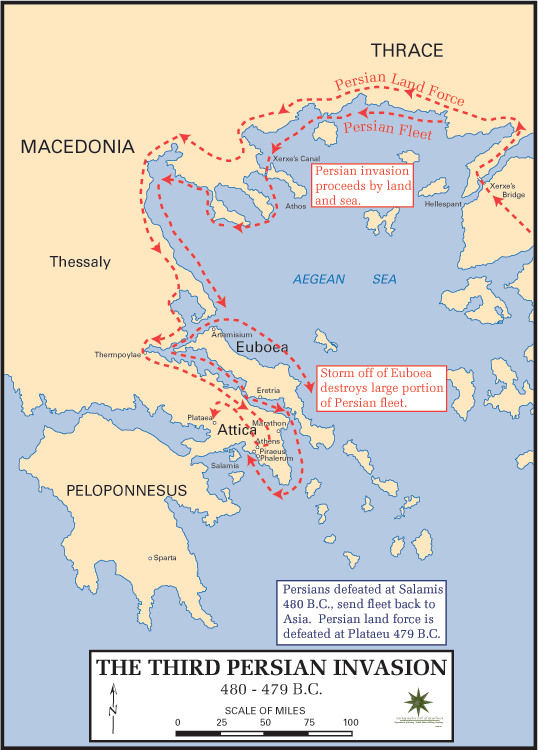 |
| File: Persian invasion.png Author: AnonMoos License: GFDL |
 |
| Peloponnesian war, 431-404 BC. File: Map Peloponnesian War 431 BC -eng.svg User: Marsyas (CC BY-SA 3.0) |
The first history book, a work by Herodotus, was about the greco-persians wars:
7. THE EMPIRE OF ALEXANDER THE GREAT.
Alexander the Great, was the son of Philip II of Macedon. Alexander was educated by the philosopher Aristotle and admired the works of Homer.He was 20 when his father died (336 BC) and inherited a kingdom that included most of Greece:
- He unified the Greek poleis to confront a common enemy,: the Persian empire.
- He conquered the Persian empire between the 334 and 324 BC creating a great empire from the Mediterranean to the Indian frontier.
- Alexander wanted to spread the greek civilization and founded numerous cities, such as Alexandria.
- Alexander tried to bring the Greek closer to eastern civilization, adopted eastern customs and married an pakistani princess, Roxana.
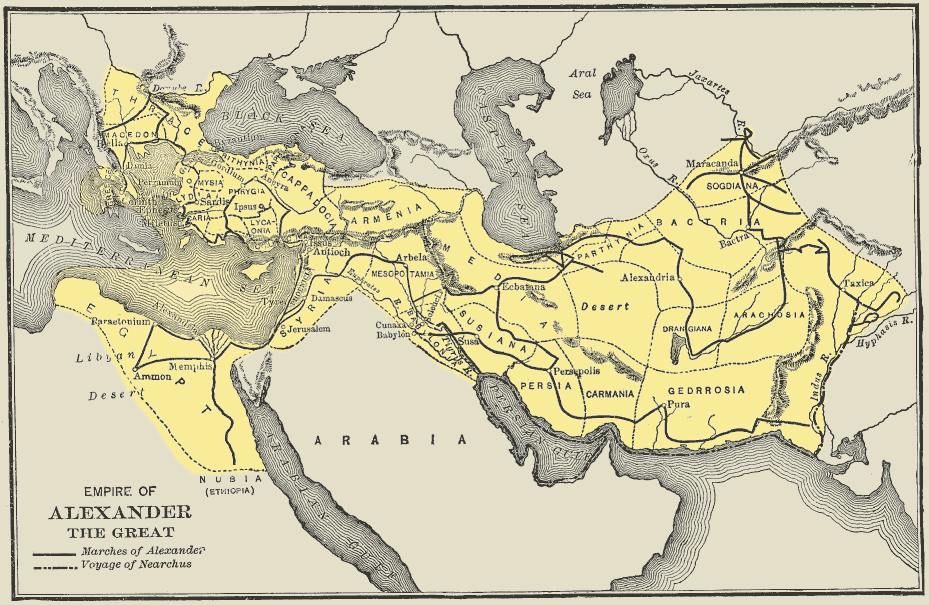
7. 2. Hellenistic monarchies.
When Alexander died, his generals divided the empire among themselves and created the Hellenistic monarchies
- Were absolute monarchies: the king had all the powers.
- Spreaded the Greek culture and art throughout the East: Hellenism.

The last battle of Alexander in India:
8. GREEK ART.
1. Architecture.
Characteristics:
Characteristics:
- They designed buildings to a human scale.
- They used stone and marble.
- They had columns and a double-sloped roof.
- They introduced orders, column arrangements, that aimed for proportion and ideal beauty. There were three: doric, jonic and corinthian.
 |
| Parthenon's replica, Nashville, Tenesse. |
 |
| http://recursostic.educacion.es/bancoimagenes/web/ (CC BY-NC-SA 3.0 ES) |
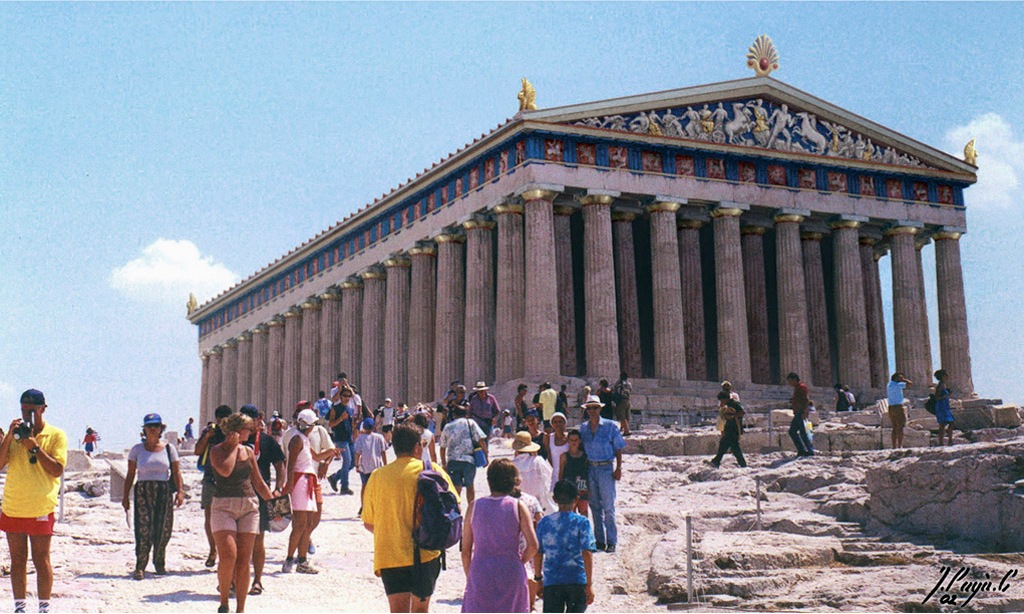 |
| Originally, greek temples and sculptures were painted with vivid colours. https://www.flickr.com/photos/arg0s/6208541055/ https://www.flickr.com/people/24630636@N03 (CC BY-SA 2.0) |
- There were two main types of buildings:
- pronaos, a vestibule.
- naos, the main room where the god's statue was located.
- opisthodomos, another room where the offerings made to the god were kept.

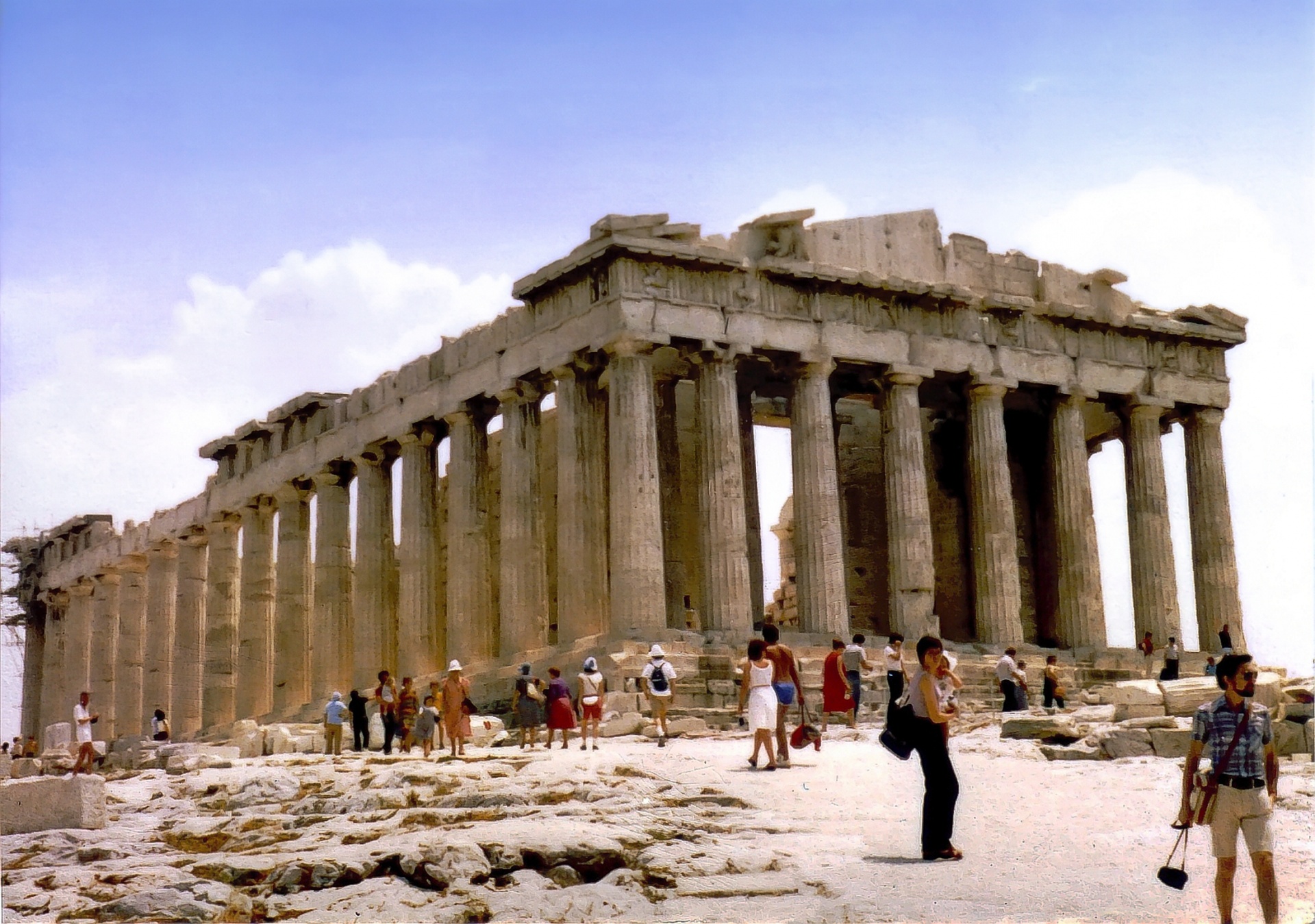
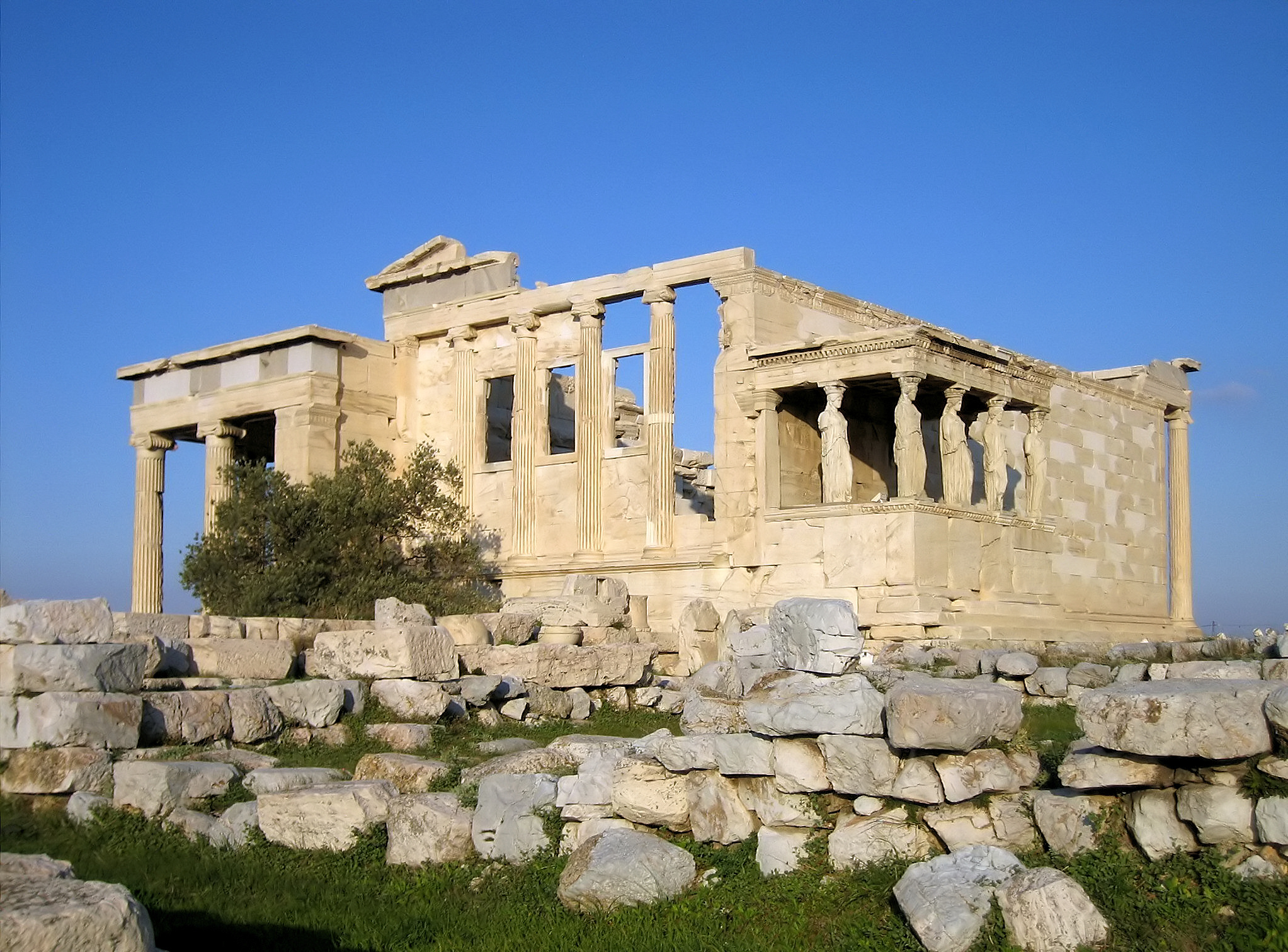
- Theatre:was used for the performance of theatre plays and was built to the advantage of mountain slopes.
Delphi theatre
Characteristics:
- About the materials, first the used wood, later polychrome marble, bronze and sometimes, ivory and gold.
- Tried to achieve idealised beauty, using a canon, a set of proportions applied to the human body.
- Great variety of subjects: gods, heroes, athletles, religious scenes and battles.
- We can distinguish several periods:
- Archaic: Rigid figures and almond-shaped eyes: Kouroi, Male naked athletes; Kouroai: Dressed females.
- Classical period: Figures in movement, more realistic but still idealised. Examples: Dyscobolus, Myron, Relief of The Parthenon and Athena, Phidias.
- Hellenistic period: They represented movement and expressions of feelings in faces and bodies. Examples: Laocoön and Winged Victory of Samothrace.
ARCHAIC PERIOD
 |
| Kouroi, archeological museum of Olympia. Attribution: Lemur12 |
 |
| Kouros. As you can see the posture is rigid, the eyes are almon-shaped and has a half-smile. File:Kouros_from_thebes.jpg User:Dmitri_Lytov Licencia: BY-SA 3.0. |
 |
| Kore, during the Archaic Period all the female sculptures had clothes. Museo Arqueológico de Atenas. |
CLASSICAL PERIOD.
 |
| Doryphoro, Polykletos. Época clásica. File: Doryphoros MAN Napoli Inv6011-2.jpg https://commons.wikimedia.org/wiki/User_talk:Tetraktys |
| Discóbolus, Myron, ejemplo de escultura de la época clásica. https://commons.wikimedia.org/wiki/User:Livioandronico2013 |
 |
| Detalle del Doriforo de Policleto. Las estatuas de la época clásica se caracterizan por la idealización (representan un belleza ideal y perfecta) y los rostros inexpresivos. https://www.flickr.com/photos/profzucker/8214894003/ Autor: https://www.flickr.com/photos/profzucker/ Licencia: by-nc-sa/2.0/ |
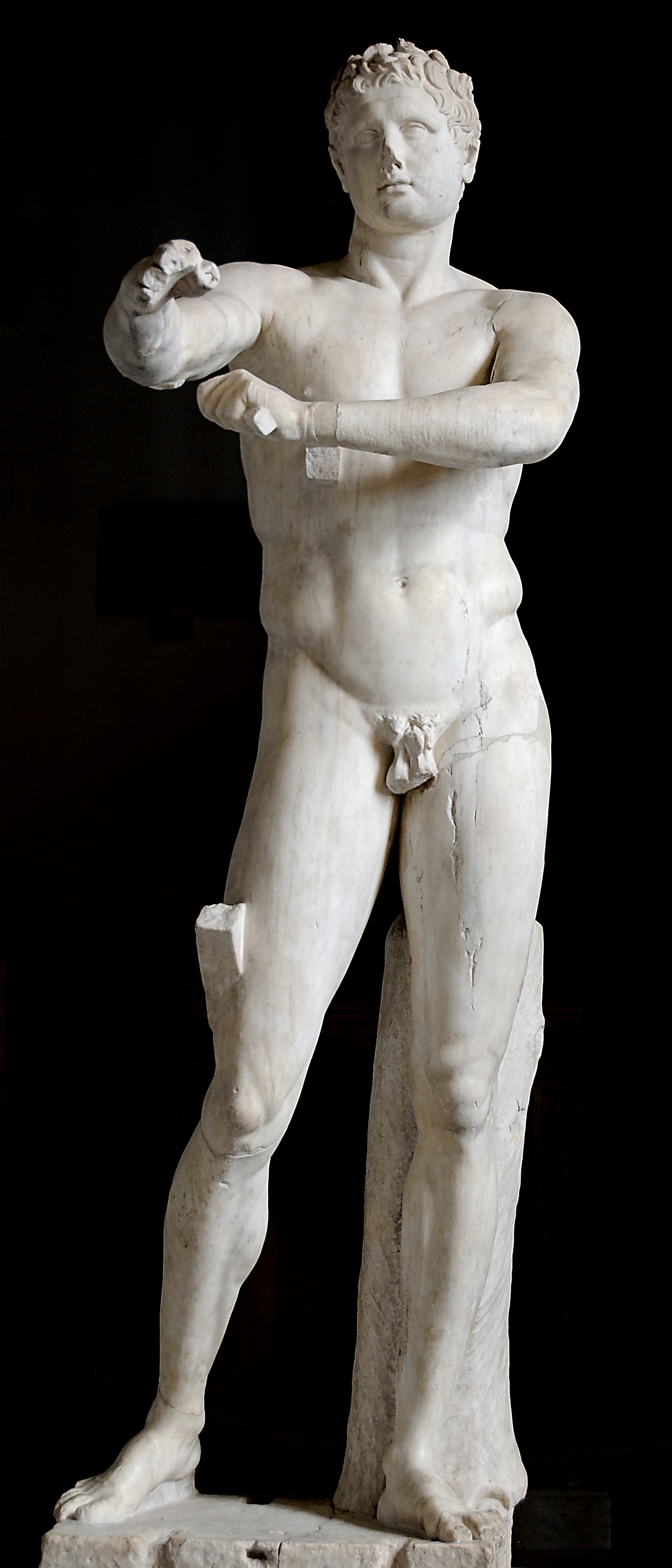 |
| Apoxiomeno, Lisipo. |
 |
| Diadumenus, Polyclitus. |
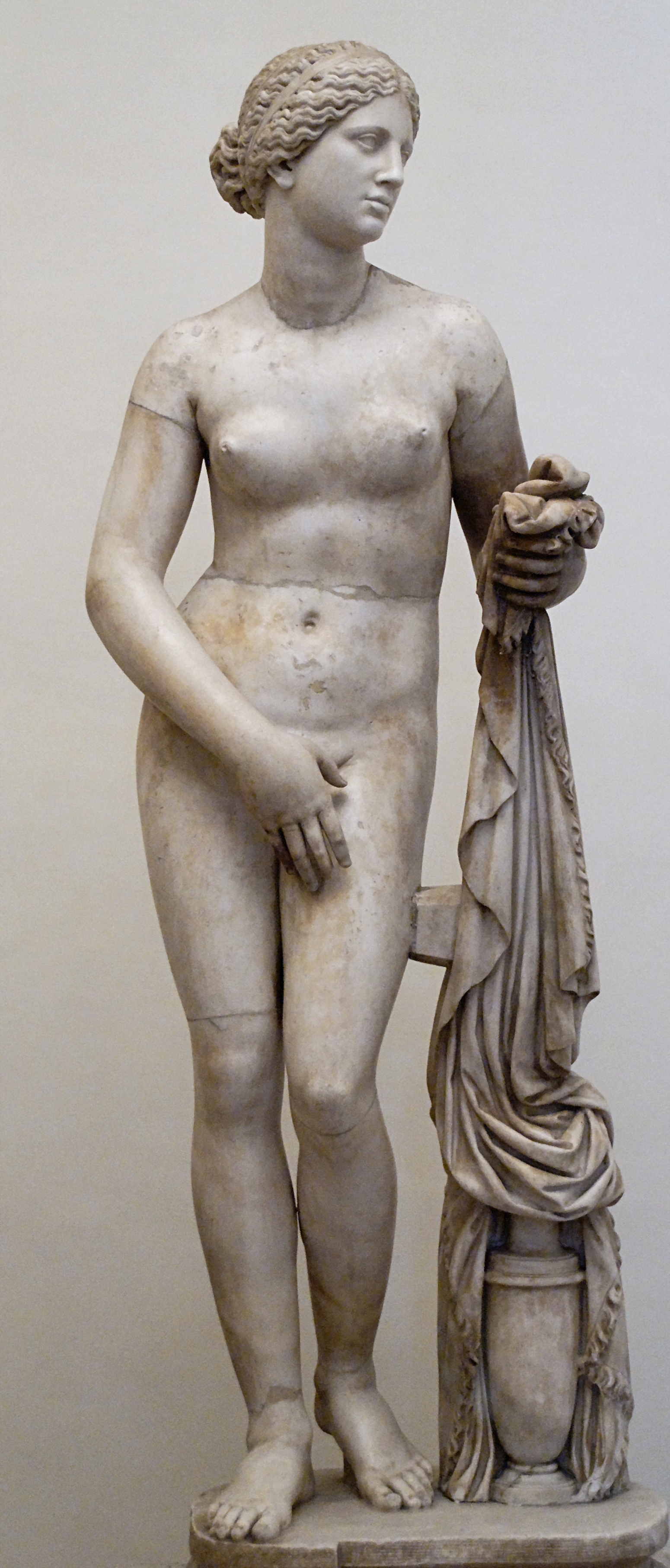 |
| Aphrodite of Knido, Praxiteles, 4th century B C. It is considered the first female nude of the greek sculpture. |
HELLENISTIC PERIOD.
.jpg) |
| Laoocon. File: 0 Laocoon Group-Museo Pro Clementino (Vatican).jpg User:Jean-Pol Grandmont |
 |
| Old woman. |
 |
 |
| Winged victory of Samothrace.. |

3. Pottery.
Characterised by a great variety of forms for every sort of use: storing grain, transporting water and mixing wine and water, etc.
In Athens there were two types according its decoration:
- red figures painted on a black background.
- black figures painted on a red background.
How identify greek orders:
A 3d reconstruction of the Parthenon.
Nashville's Parthenon lit with the original colours:
3d reconstruction of the acropolis of Athens and Agrigentum:
9. CHRONOLOGY:
776 BC. The first olympic games. Start of the Archaic Period.490-479 BC. Greco-Persian Wars. Start of the Classic Period.
490 BC. Battle of Marathon.
480 BC. Battle of Salamis.
477 BC. Delian League.
431 BC. Start of the Peloponnesian war.
404 BC. End of the Peloponnesian war. Hegemony of Sparta.
338 BC. Battle of Cheronea. Philip II conquered Greece.
323 BC. Death of Alexander the Great. Start of the Helenistic Period.
30 BC. Conquer of the Ptolemaic kingdom by Rome. End of the greek civilization.
CURIOSITIES:
The Ancient greeks, specially during the Helleinistic period, developed some impressive technological advances, such as:
-the first mechanical computer:
-the first steam engine.
-the first mechanical doors
10. REVIEW ACTIVITIES.
Exe learning activity about Greece
2. FILL THE BLANK SPACES.

SOLUTIONS.
1. REVIEW GAME.

2. FILL THE BLANK SPACES.

3. MAPS.
The exam is going to include one or maybe two maps. Here you can find the maps that can be a part of the exam.
a). Political map of Ancient Greece.
You have to be able to locate in the map at least: Athens, Attica, Sparta, Laconia, Macedonia and the Aegean Sea. Also, you have to be able to identify the territory of the Ancient Greece: Ellas or Hellada.
b). Empire of Alexander the Great.
Remember, if in a map Egpyt, Asia Minor Mesopotamia, Persia and Greece are part of the same empire, have to be the empire of Alexander the Great. Also, you have to know the location of the most important city founded by Alexander, Alexandria.
c). The hellenistic kingdoms.
If in a map appears Egpyt as a independent kingdom led by the ptolemaic dinasty and independent Macedonia and a kingdom in Syria and Asia Minor has to be about the Hellenistic kingdoms.








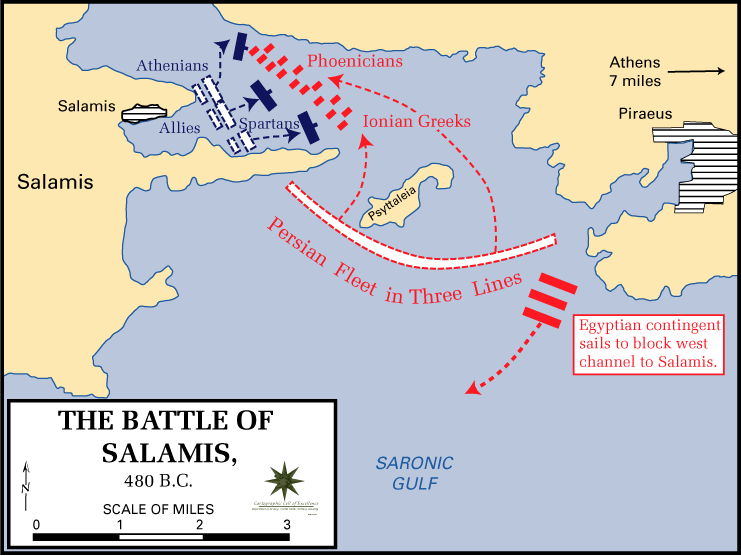




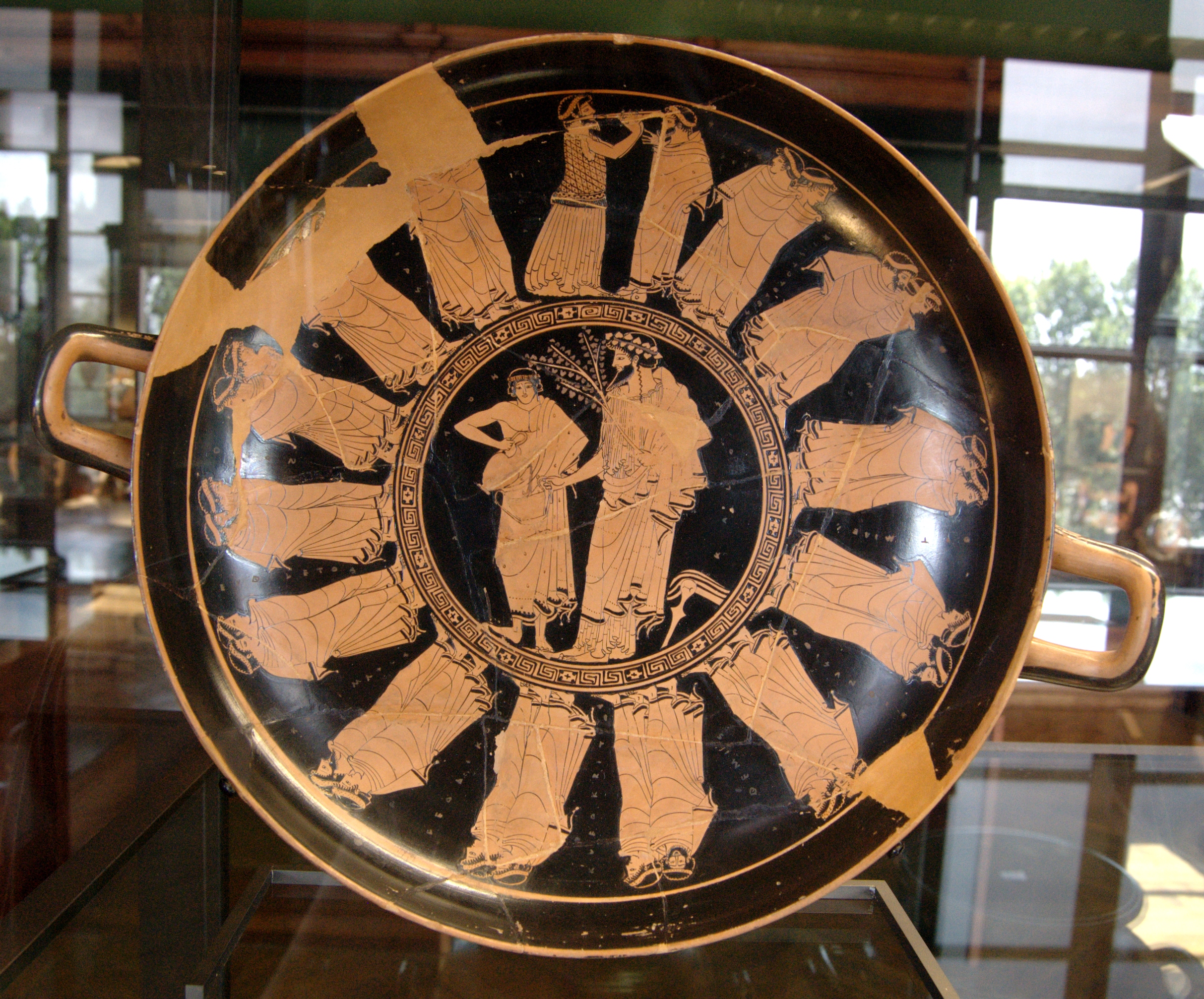
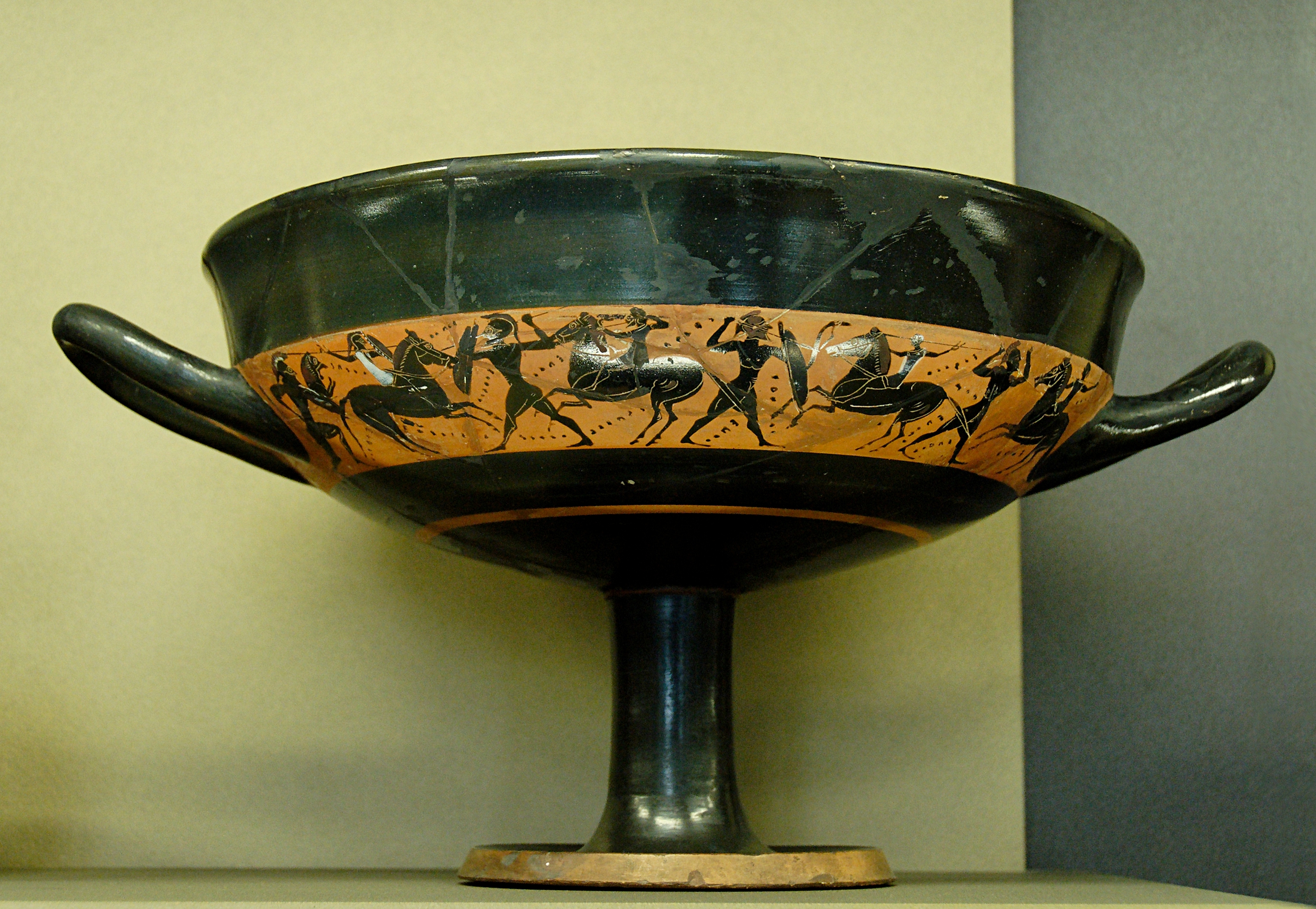




have you put the whole unit?
ResponderEliminarMore or less, I still have to change some things.
Eliminarok thanks
EliminarGema, I have already included all the contents of the unit about Ancient Greece. I want to include some review activities but these are the contents that are going to be a part of the exam.
Eliminarokayyyyyyyyy
Eliminarthanks
teacher
ResponderEliminarwhen was the exam???
Wednesday, May 30. Sorry, it can't be later.
Eliminarok thanks
Eliminar